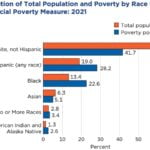Social safety nets have been effective in reducing U.S. poverty over the past 50 years, according to a report released by the Center on Budget and Policy Priorities (CBPP) on Sept. 14.
Analyzing U.S. Census Bureau data from 1967 to 2017, CBPP found that government economic security measures – such as Social Security, food assistance programs, rental subsidies and tax credits – have almost halved poverty.
CBPP used the Supplemental Poverty Measure (SPM) for its analysis. This measure differs from other poverty measures because it accounts for other income, such as government assistance program benefits, instead of only pre-tax cash income.
“The SPM poverty rate fell from 25.1 percent in 1967 to 13.9 percent in 2017, with most of this improvement coming from the increased anti-poverty impact of economic security programs. … At 13.9 percent, the SPM poverty rate in 2017 was statistically tied with the record low of 14.1 percent in 2000, with data going back to 1967,” the report said. “Measured with the SPM, the child poverty rate remained at a record low of 15.6 percent in 2017, statistically tied with 2016’s record low – and a little more than half its 1967 level of 28.6 percent.”
The impact of social safety net programs (economic security measures) has increased significantly, CBPP found, helping only 5 percent of recipients to move above the poverty line in 1967 but enabling 44 percent of recipients to do so in 2017.
U.S. poverty thresholds are established each year by the U.S. Census Bureau.
The disparity in poverty measures is clearly seen when comparing analyses that account for cash income only and those that include government assistance.
In 2017, 25 percent of all U.S. adults were below the poverty line when only cash income was considered, compared to 13.9 percent when cash income and economic security measures were included.
A similar reduction was noted among persons 18 and younger, with a 24.6 percent poverty rate with cash only income considered and a 15.6 percent rate when all income and benefits were analyzed.
“Some policymakers and pundits have argued that federal anti-poverty programs have failed, noting that the official poverty rate fell sharply between 1959 and 1969 but has changed relatively little since then, apart from fluctuations due to the business cycle,” the report said. “However, comparing poverty rates in the 1960s and today using the official poverty measure yields misleading results because the official measure doesn’t count programs like SNAP, the EITC and rental assistance, which now constitute a much larger part of the safety net than 50 years ago, and which most poverty analysts favor including in the poverty measure.”
The full report is available here.





